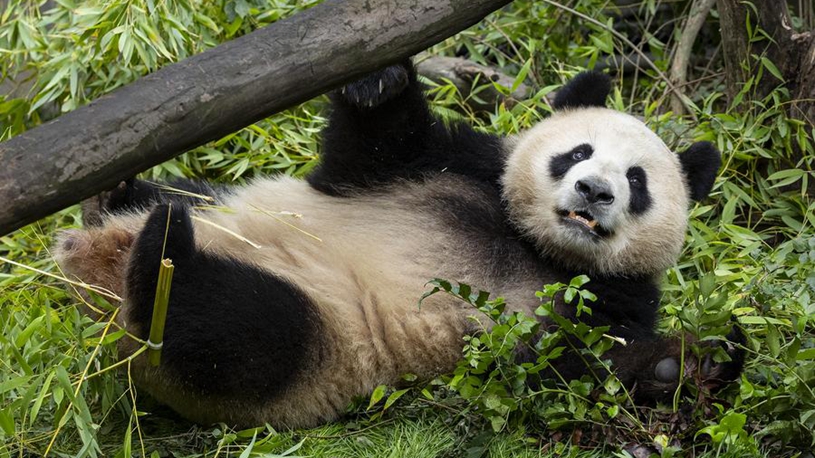* As one of China's major goji berry-producing regions, Ningxia currently boasts 325,000 mu (about 21,667 hectares) of goji berry cultivation area. With the expansion of cultivation areas, goji berries from Ningxia have not only brought greenery to barren land but also become a significant source of wealth for the locals in the region.
* Ningxia has implemented over 270 scientific and technological projects, with nearly 290 million yuan invested specifically in goji berry-related initiatives.
* Ningxia has developed more than 120 kinds of goji berry products, including food, drinks and cosmetics, which have been exported to more than 50 countries and regions around the world.
YINCHUAN, Aug. 11 (Xinhua) -- Over a decade ago, Hu Yuzhu could never have imagined that her hometown in the arid desert of northwest China's Ningxia Hui Autonomous Region would one day transform into an oasis.
Today, Mingsha Town in Ningxia's Zhongwei City has been turned into a lush oasis adorned with trees bearing branches laden with red fruits. It has become a vital resource for Hu, her fellow villagers and migrant workers, improving their livelihoods.
The transformations are largely due to the goji berries, also known as wolfberries, a Ningxia specialty famous for their nutritional value. Dubbed as "magic berries," the goji berries have been used in traditional Chinese medicine for thousands of years.
As one of China's major goji berry-producing regions, Ningxia currently boasts 325,000 mu (about 21,667 hectares) of goji berry cultivation area. With the expansion of cultivation areas, goji berries from Ningxia have not only brought greenery to barren land but also become a significant source of wealth for the locals in the region.
Also, thanks to advancements in sci-tech innovation in the industry, goji berry products from the region have diversified and reached a wider consumer base over the years.
BETTER ENVIRONMENT, LIVELIHOODS
Mingsha Town, located in the central arid zone of Ningxia, once endured sandstorms and droughts, with sandy and saline-alkali soil making crop cultivation challenging. Despite these challenges, the area boasts unique natural advantages, including prolonged sunshine hours and significant day-night temperature variations.
Taking advantage of these favorable conditions, the Xizan Manor Goji Co., Ltd. started establishing the Xizan ecological goji berry plantation in Mingsha in 2013, carrying out comprehensive transformation and utilization of surrounding barren and saline-alkali land.
Zhu Xiaobing, deputy director of the production center at the Xizan plantation, recalled that in 2013, sometimes the goji berry seedlings measuring 20 cm tall would disappear after a night of sandstorms, and workers often found their tents blocked by sand after waking up in the morning.
Despite the challenges, everyone persevered to prepare for planting seedlings in April the following year. By spring 2014, 450,000 goji berry seedlings were planted on the barren land, with a survival rate of 90 percent, Zhu said.
To ensure the quality of goji berries, the plantation adopted a standardized planting model, with a specific number of goji berry trees planted per mu of land. This approach not only facilitates mechanized farming but also ensures adequate soil area, optimal ventilation and favorable lighting conditions, Zhu explained.
After over 10 years of tree planting, the once barren land has been transformed into a goji berry plantation covering over 10,000 mu, encouraging more locals to work in this sector to improve their financial prospects.
Hu, a villager from Mingsha, has been working at the plantation for six years. Her daily work includes picking fresh goji berries, which will later be processed into dried berries and puree, among other products.
"My husband and I both work at the plantation area and together we earn nearly 10,000 yuan (about 1,400 U.S. dollars) per month. We have bought a house and a car in the county seat. Our life now is much better," she said.
Hu is not alone. Statistics show that over 270,000 people are directly employed in the goji berry industry in Ningxia.
INNOVATION BOOSTS POPULARITY
In recent years, Ningxia has focused on promoting the high-quality development of the modern goji berry industry through enhanced basic research, more focus on achieving sci-tech breakthroughs and strengthened support for tech enterprises. The region has implemented over 270 scientific and technological projects, with nearly 290 million yuan invested specifically in goji berry-related initiatives.
Thanks to these efforts, Ningxia has developed more than 120 kinds of goji berry products, including food, drinks and cosmetics, which have been exported to more than 50 countries and regions around the world.
"From the fields to the workshops and then to the consumers, every quality goji berry has a story of sci-tech innovation behind it," said Hao Xiangfeng, president of the Ningxia goji berry association and chairman of Beryl Gojiberries Co., Ltd., a leading goji berry producer in the region.
According to Hao, through joint cooperation with universities and research institutes such as China Agricultural University, the company has acquired more than 40 patents, including the "fresh-locked goji berry" technology. According to him, this technology reduces drying time from 120 to 20 hours, preserving moisture and nutrients, resulting in vibrant color and a softer texture.
"Today, a gram of fresh-locked goji berry can fetch up to 1.2 yuan, dozens of times higher than before," Hao said, adding that the company invests more than 10 million yuan in research and development every year.
Fueled by growing consumer demand for health-conscious products, goji berry products have garnered popularity among an expanding global consumer base.
El Batoul Nejjaoui from Morocco, who has been working in Ningxia for five years, brings local specialties such as dried goji berries whenever she visits Morocco. "My family loves goji berries, especially my mother. She hopes to see Ningxia goji berry products in supermarkets in Morocco in the future," she said.
From January to April, Ningxia exported 1,331.2 tonnes of goji berries to countries and regions including Germany and the United States, up 15.3 percent year on year, customs data showed. According to a development plan for this sector, the region's goji berry industrial chain is expected to reach 100 billion yuan in output value by 2030.
(Video reporters: Liu Hai, Xie Jianwen and Ma Sijia; Video editors: Lin Lin, Roger Lott, Wei Yin and Zheng Xin.)■












